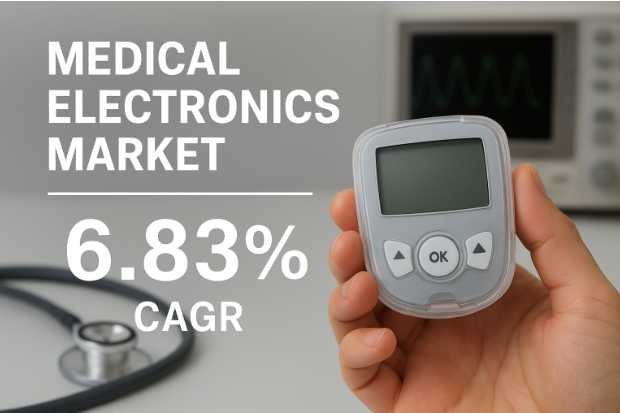The Medical Electronic Market is experiencing rapid growth as healthcare systems across the world continue to adopt advanced digital technologies and electronic devices. From diagnostic imaging systems to wearable health monitors, electronics have become an integral part of modern medicine. These innovations are enabling doctors to deliver faster, more accurate diagnoses and provide better patient outcomes through real-time data and connected care solutions. As the demand for efficient healthcare services increases, the role of medical electronics in improving accessibility, accuracy, and affordability continues to strengthen.
Medical Electronic Market Size and Growth Forecast
As per the SNS Insider, the Medical Electronic Market was valued at USD 10.51 billion in 2023 and is projected to reach USD 19.04 billion by 2032, expanding at a CAGR of 6.83% during the forecast period of 2024–2032. This strong growth is attributed to the rising adoption of smart healthcare technologies, growing investments in medical device innovation, and increasing awareness about patient monitoring and personalized healthcare. As hospitals, clinics, and diagnostic centers transition to connected systems, the demand for electronic components like sensors, microcontrollers, and semiconductors in medical devices is surging.
Key Drivers Fueling the Medical Electronic Market
The expansion of the Medical Electronic Market is primarily driven by three major factors — technological innovation, increased healthcare expenditure, and the growing prevalence of chronic diseases. Firstly, advancements in electronics and miniaturization technology have made it possible to develop compact, energy-efficient, and cost-effective devices. Secondly, governments and private organizations are investing heavily in healthcare infrastructure to meet the needs of aging populations. Thirdly, the rise in chronic diseases such as diabetes, cardiovascular disorders, and respiratory illnesses has accelerated the demand for continuous patient monitoring systems and diagnostic tools. Together, these factors are transforming the healthcare industry, making electronic-based medical care more reliable and precise.
Medical Electronic Market Trends Shaping the Future
Emerging trends are significantly reshaping the Medical Electronic Market landscape. One of the most notable trends is the integration of artificial intelligence (AI) and Internet of Things (IoT) in medical devices. AI-powered systems enable early disease detection through predictive analytics, while IoT connectivity allows remote patient monitoring and data sharing between healthcare providers. Another key trend is the increasing adoption of wearable medical electronics, such as smartwatches and biosensors, which help track vital parameters like heart rate, glucose levels, and oxygen saturation in real time. Additionally, 3D printing and robotics are revolutionizing the manufacturing and functionality of complex medical electronics, improving precision in surgeries and treatment delivery.
Challenges in the Medical Electronic Market
Despite its remarkable progress, the Medical Electronic Market faces several challenges that may restrain its full potential. One of the main issues is the high cost of advanced electronic medical devices, which limits adoption in low- and middle-income countries. Furthermore, data security and privacy concerns have become major challenges as more medical devices are connected to the internet. Cybersecurity threats can compromise sensitive patient data and disrupt hospital systems. Lastly, regulatory compliance is another obstacle, as manufacturers must adhere to stringent government standards before introducing new devices to the market. Overcoming these challenges will require collaboration between technology developers, healthcare providers, and regulatory authorities.
Regional Insights: Growth of the Medical Electronic Market Across the Globe
Regionally, the Medical Electronic Market is witnessing significant growth across North America, Europe, and Asia-Pacific.
North America currently dominates the market due to its advanced healthcare infrastructure, high adoption of digital technologies, and continuous R&D investments. The U.S. in particular is a key contributor, with several leading medical device manufacturers based in the region.
Europe follows closely, driven by strong regulatory frameworks, growing demand for patient-centric care, and government initiatives supporting electronic health solutions.
Asia-Pacific is projected to register the fastest growth rate during the forecast period. Countries like China, India, and Japan are witnessing a surge in healthcare modernization, fueled by expanding medical tourism, government health programs, and increased spending on hospital digitalization.
The Middle East, Africa, and Latin America are also emerging markets, offering significant growth potential as they invest in modern healthcare technologies.
Future Outlook of the Medical Electronic Market
The future of the Medical Electronic Market looks promising, with continuous innovation paving the way for smarter, safer, and more efficient healthcare systems. As electronic components become smaller, faster, and more energy-efficient, their integration into medical devices will continue to expand. The ongoing shift toward telemedicine, remote monitoring, and AI-assisted healthcare will further accelerate market growth. Moreover, the global push for value-based healthcare — focused on improving patient outcomes while reducing costs — will drive increased reliance on medical electronics for accurate diagnostics and timely interventions.
Conclusion: Medical Electronics Revolutionizing Modern Healthcare
In conclusion, the Medical Electronic Market stands at the forefront of the global healthcare transformation. With its ability to enhance diagnostics, improve treatment precision, and enable real-time monitoring, medical electronics have become the backbone of modern medical technology. The market’s expected expansion to USD 19.04 billion by 2032 underscores its potential and the growing trust of healthcare providers in digital and electronic solutions. As the world moves toward smarter healthcare, medical electronics will play an even greater role in making patient care more accessible, efficient, and personalized.
FAQs about the Medical Electronic Market
1. What is the CAGR of the Medical Electronic Market during 2024–2032?
2. The Medical Electronic Market is projected to grow at a CAGR of 6.83% from 2024 to 2032, reflecting the increasing integration of digital technology and AI in healthcare systems.
2. What is the forecast period and expected market size by 2032?
The forecast period for the market is 2024–2032, during which the Medical Electronic Market is anticipated to reach USD 19.04 billion by 2032, up from USD 10.51 billion in 2023.
3. Which region is expected to lead the Medical Electronic Market growth?
North America currently dominates the market due to its advanced healthcare infrastructure and technological innovation. However, Asia-Pacific is expected to experience the fastest growth rate, driven by rapid healthcare modernization and increasing adoption of medical electronics.




















